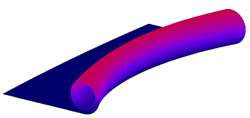Graphene: Can the Newest Form of Carbon Be Made to Bend, Twist and Roll

(PhysOrg.com) -- Can graphene -- a newly discovered form of pure carbon that may one day replace the silicon in computers, televisions, mobile phones and other common electronic devices -- be made to bend, twist and roll?
Physicists at UC San Diego and Boston University think so. In a paper published in the journal Physical Review B, the scientists say the propensity of graphene—a single layer of carbon atoms arranged in a honeycomb lattice— to stick to itself and form carbon “nanoscrolls” could be controlled electrostatically to form a myriad of new devices.
Unlike carbon nanotubes—cylindrical molecules of pure carbon with novel properties that have become the focus of much of the attention of new application in electronics and materials development—carbon nanoscrolls retain open edges and have no caps.
“As a result, nanoscrolls can change their shape and their inner and outer diameters, while nanotubes cannot,” said Michael Fogler, an associate professor of physics at UCSD and the first author of the paper.
Working with Antonio Castro Neto, a physics professor at Boston University, and Francisco Guinea of the Institute of Materials Science in Madrid, the scientists proposed the construction of a device in which the electronic properties of graphene are used to roll and unroll the nanoscroll.
“The device we envision is a graphene nanoscroll that can be charged by current from a nearby electrode,” said Fogler. “The more charged it becomes, the more the mutual electrostatic repulsion of electrons inside the scroll causes it to unwrap. So, the voltage on the electrode can control the diameter and the number of coils in the scroll.”
“We show in this paper that the electrostatic control of nanoscrolls is very much feasible. The required voltages are in the practical range. Since graphene is so light, the wrapping and unwrapping would occur on a time scale of one-trillionth of a second. So, not only the degree of scrolling can be controlled, these nano-electromechanical devices will also be ultra-fast.”
Fogler said such nanoscrolls could have a wide range of applications, such as actuators whose operation resembles the blinking of one’s eyes, valves in lab-on-a-chip devices and even a form of electronic paper. Previously, other scientists attempted to build scroll “machines” using thin plastic films but they were either too rigid or too frail to work well. In contrast, nanoscrolls made of graphene, which is mechanically stronger than any other material known to man, would be robust, yet remain ultra-light and ultra-flexible. They would also conduct electricity more than a thousand times better than silicon.
Fogler said that the ideas to use electrical properties of graphene to modify its structure, or vice versa, are still quite new, and so the proposed devices may require some time to develop. In the near term, scientists hope that graphene, which is an optically transparent conductor of electricity, could be used to replace current liquid crystal displays that employ thin metal-oxide films based on indium, a rare metal that is becoming increasingly expensive and likely to be in short supply within a decade.
More information: An advance copy of the journal article appeared online this week at: link.aps.org/doi/10.1103/PhysRevB.81.161408
Provided by University of California - San Diego



















